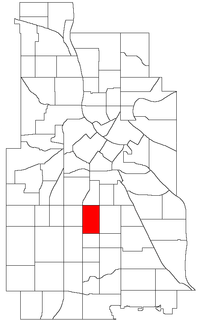Central (neighborhood), Minneapolis: Difference between revisions
Content deleted Content added
m Stub-sorting. You can help! |
c |
||
| Line 79: | Line 79: | ||
Developed mostly between 1900 and 1930, the Central neighborhood is racially diverse and has drawn African-American residents since the 1920s. Until it was closed in 1982 and later razed, Central High School was located here ([[Prince (artist)|Prince]] graduated from Central in 1976). |
Developed mostly between 1900 and 1930, the Central neighborhood is racially diverse and has drawn African-American residents since the 1920s. Until it was closed in 1982 and later razed, Central High School was located here ([[Prince (artist)|Prince]] graduated from Central in 1976). |
||
{{Coord|44.9415|-93.2709|region:US-MN_type:city(8150)_source:GoogleEarth|display=title|notes=<ref>''Central, Minneapolis, MN.'' [[Google Earth]]. Retrieved 2011-03-09.</ref>}} |
|||
==References== |
==References== |
||
| Line 100: | Line 101: | ||
}} |
}} |
||
{{Coord missing|Minnesota}} |
|||
[[Category:Neighborhoods in Minneapolis, Minnesota]] |
[[Category:Neighborhoods in Minneapolis, Minnesota]] |
||
Revision as of 23:20, 13 March 2011
- This article is about the neighborhood in south Minneapolis. For the Central community of Minneapolis, which includes downtown, see Central, Minneapolis
Central | |
|---|---|
 Location of Central within the U.S. city of Minneapolis | |
| Country | United States |
| State | Minnesota |
| County | Hennepin |
| City | Minneapolis |
| Community | Powderhorn |
| Population | |
| • City | 8,150 |
| • Urban | 387,970 |
| • Metro | 3,502,891 |
| Time zone | UTC-6 (CST) |
| • Summer (DST) | UTC-5 (CDT) |
| ZIP code | 55407, 55408, 55409 |
| Area code | 612 |
| Census | Pop. | Note | %± |
|---|---|---|---|
| 1980 | 7,147 | — | |
| 1990 | 7,521 | 5.2% | |
| 2000 | 8,150 | 8.4% |
The Central neighborhood (part of the larger Powderhorn community) of Minneapolis, Minnesota is located south of the downtown region of the city. It is bounded by Lake Street on the north, Chicago Avenue on the east, 38th Street on the south, and Interstate 35W on the west. It should not be confused with the Central community, which covers Downtown and some surrounding neighborhoods.
Developed mostly between 1900 and 1930, the Central neighborhood is racially diverse and has drawn African-American residents since the 1920s. Until it was closed in 1982 and later razed, Central High School was located here (Prince graduated from Central in 1976). 44°56′29″N 93°16′15″W / 44.9415°N 93.2709°W[3]
References
- ^ "Twin Cities Region Population and Household Estimates, 2006" (PDF). Metropolitan Council. 2006-04-01. Retrieved 2007-07-24.
- ^ "Table 2: Population Estimates for the 100 Most Populous Metropolitan Statistical Areas Based on July 1, 2006 Population Estimates: April 1, 2000 to July 1, 2006" (PDF). U.S. Census Bureau. 2007-04-05. Retrieved 2007-04-16.
- ^ Central, Minneapolis, MN. Google Earth. Retrieved 2011-03-09.
External links
